Ever heard of anyone paying 60% tax? Chances are not, since, according to HMRC, Income Tax is charged at 0%, 20%, 40% or 45%, depending on how much you earn. The rates are slightly different in Scotland, but a 60% rate of tax doesn’t seem to exist. However, higher-rate taxpayers beware.
At a glance
- If you’re a higher-rate taxpayer, you might end up paying more tax than you bargained for.
- If you earn between £100,000 and £125,140, the tapering of the personal allowance means you could end up paying 60% tax.
- Tax rules change frequently but financial advice can help make sure you stay tax-smart, and always pay what you owe, and no more.
Ever heard of anyone paying 60% tax? Chances are not, since, according to HMRC, Income Tax is charged at 0%, 20%, 40% or 45%, depending on how much you earn. The rates are slightly different in Scotland, but a 60% rate of tax doesn’t seem to exist. However, higher-rate taxpayers beware.
If there’s one word to describe the UK tax system, it’s ‘complicated’. It’s easy to misinterpret the rules, and end up making some expensive mistakes, if you fall into one of the hidden tax ‘sinkholes’.
The hidden 60% tax sinkhole
A prime example is the 60% income tax trap. It’s not published in any HMRC guidelines because it’s an unofficial effective rate of Income Tax. It occurs as a result of the tapering of the personal allowance for higher earners. The result? Those earning between £100,000 and £125,140 can end up paying 60% tax.
Even if it doesn’t apply to you, it’s worth knowing that taxes can appear almost by stealth, and certainly by surprise, in all sorts of different places. Like tax ‘sinkholes’.
“What the 60% rate represents is that these ‘sinkholes’ can appear anywhere – tax allowances change frequently and those changes can affect you,” warns Melloney Underhill, Head of Marketing Insights at St James’s Place. “For anyone earning more than £80,000 or so, the Chancellor has the opportunity every tax year to amend the threshold and the rules in a way that might have a big impact on you – and your money.”
You can mitigate and even avoid this sinkhole completely, with the right financial advice and a little bit of careful forward planning.
Why the 60% tax trap happens
If you earn £100,000 or more, the £12,570 personal allowance is slowly reduced. The personal allowance is the amount of income you can earn each year without paying Income Tax. It’s currently tapered away at a rate of £1 for every £2 you earn above £100,000.
In hard terms, this means that for every £100 of income between £100,000 and £125,140, you only get to take £40 home – £40 is deducted in Income Tax, while another £20 is lost by the tapering of the personal allowance. This amounts to a 60% tax rate. Once you’re earning £125,140 or more, you don’t get any personal allowance at all.
Sidestep the 60% tax trap – top up your pension
So, how can you ‘reduce’ your income to bring it back below the 60% threshold? “The quickest and simplest way is to pay more into your pension before tax-year end, so you reduce the earnings that fall into that bracket” suggests Underhill. “This way you save Income Tax and boost your retirement fund at the same time."
Let’s say you get a £1,000 pay rise, which takes your taxable income to £101,000. If you pay that £1,000 into your pension, you won’t enter the 60% tax zone and you’ll get the benefit of a 40% top-up on your contribution, thanks to pension tax relief.
Just FYI, you can pay a maximum of £40,000 into your pension each year, and still enjoy tax relief on your contributions.
Managing your pension to cut your tax bill
Topping up your pension before tax-year end can reduce the amount of tax you pay in a number of ways. Any contribution you make reduces your taxable income – so if you can, it’s good to pay in as much as you can afford this year.
You could use a well-timed pension contribution to sidestep the higher-rate tax band and avoid paying more Income Tax.
High-income Child Benefit is a tax charge on families where one partner has a net adjusted income of more than £50,000. This is another charge that uses tapering, with an extra 1% deduction of the amount of Child Benefit for every £100 of income over £50,000. Once again, you can use pension contributions to massage your income back down below the threshold.
Taking financial advice
Tax rules are complicated and, as we’ve seen several times this year, can change frequently. We’re always up to speed with the latest changes means we’ve always got your back. We’ll flag any changes that could impact – positive or negative – your personal finances, and help you decide what action to take.
Checking in with us regularly means you can often swerve around any sinkholes or legally mitigate them. As Underhill says: “You are on your own personal financial journey, driven by so many other factors, not just tax. All of which impact your choices and financial planning. But we all need to be mindful of how the Chancellor can affect our personal financial goals.”
“We’re here to work with you and help you navigate the ever-changing landscape.”
The value of an investment with St. James's Place will be directly linked to the performance of the funds selected and may fall as well as rise. You may get back less than the amount invested.
The levels and bases of taxation, and reliefs from taxation, can change at any time and are generally dependent on individual circumstances.
Beaumont Gibbs works in association with Futurum Financial Advice. If you would like to get in touch with someone there, click on this link:
https://futurumfa.co.uk/contact
